Princes of Condé
| House of Bourbon-Condé | |
|---|---|
  | |
| Parent house | House of Bourbon[a] |
| Place of origin | Condé-en-Brie, France |
| Founded | 1557 |
| Founder | Louis I de Bourbon, Prince of Condé |
| Final head | Louis Henri de Bourbon, Prince of Condé |
| Titles | Prince of Condé Prince of La Roche-sur-Yon Duke of Enghien Duke of Bourbon Duke of Montmorency Duke of Mercœur Marquis of Graville Count of La Marche Count of Pézenas Count of Alais Count of Clermont Prince du sang |
| Properties | Château de Chantilly Château de Condé Château de Vallery Hôtel de Bourbon-Condé Hôtel de Condé Palais Bourbon |
| Dissolution | 1830 |
| Cadet branches | Princes of Conti Counts of Soissons |
The Most Serene House of Bourbon-Condé (pronounced [buʁbɔ̃ kɔ̃de]), named after Condé-en-Brie (now in the Aisne département), was a French princely house and a cadet branch of the House of Bourbon. The name of the house was derived from the title of Prince of Condé (French: prince de Condé) that was originally assumed around 1557 by the French Protestant leader Louis de Bourbon (1530–1569),[1] uncle of King Henry IV of France, and borne by his male-line descendants.
This line became extinct in 1830 when his eighth-generation descendant, Louis Henri Joseph de Bourbon, died without surviving male issue. The princely title was held for one last time by Louis d'Orléans, Prince of Condé, who died in 1866.
History
The Princes of Condé descend from the
It had passed from the
Duc de Bourbon
After the extinction in 1527 of the Dukes of Bourbon, François's son Charles (1489–1537) became head of the House of Bourbon, which traces its male-line descent from Robert, Count of Clermont (1256–1318), a younger son of France's Saint-King Louis IX. Of the sons of Charles of Vendôme, the eldest, Antoine, became jure uxoris King of Navarre and fathered Henry IV.

The youngest son, Louis, inherited the lordships of
Louis, the first Prince, actually gave
Monsieur le Prince
Upon the accession to France's throne of


However, the position of premier prince devolved upon the
Later
After the death of
The couple had many children and produced an heir to the Condé titles and lands. Their son was Louis Henri de Bourbon-Condé, duc de Bourbon. He led a quiet life and was known at court as
His son married the sister of
After his death in 1830 the Condé lands passed to the last prince's cousin
Simplified Bourbon family tree
From Louis IX to Louis XIV
Ascelina De Bourbon Trần Ngọc Dung ( Grand Princess of France) Last descendant of Bourbon dynasty
Direct Capetians | |||||||||||||||||||||||||||||||||||||||||||||||||||||||||||||||||||||||||||||||
| Louis IX King of France 1214–1270 r. 1226–1270 | Margaret of Provence 1221–1295 | ||||||||||||||||||||||||||||||||||||||||||||||||||||||||||||||||||||||||||||||
| House of Bourbon | |||||||||||||||||||||||||||||||||||||||||||||||||||||||||||||||||||||||||||||||
| Philip III King of France 1245–1285 r. 1270–1285 | Robert Count of Clermont 1256–1317 r. 1268–1317 | Beatrice of Burgundy 1257–1310 | |||||||||||||||||||||||||||||||||||||||||||||||||||||||||||||||||||||||||||||
| House of Valois | |||||||||||||||||||||||||||||||||||||||||||||||||||||||||||||||||||||||||||||||
| Charles Count of Valois 1270–1325 r. 1284–1325 | Louis I Duke of Bourbon 1279–1341 r. 1327–1341 | Mary of Avesnes 1280–1354 | |||||||||||||||||||||||||||||||||||||||||||||||||||||||||||||||||||||||||||||
| Philip VI King of France 1293–1350 r. 1328–1350 | |||||||||||||||||||||||||||||||||||||||||||||||||||||||||||||||||||||||||||||||
| John II King of France 1319–1364 r. 1350–1364 | Isabella of Valois 1313–1383 | Peter I Duke of Bourbon 1311–1356 r. 1342–1356 | James I Count of La Marche 1319–1362 r. 1356–1362 | Jeanne of Châtillon 1320-1371[3] | |||||||||||||||||||||||||||||||||||||||||||||||||||||||||||||||||||||||||||
| Charles V King of France 1338–1380 r. 1364–1380 | Joanna of Bourbon 1338–1378 | Louis II Duke of Bourbon 1337–1410 r. 1356–1410 | Peter II Count of La Marche 1342–1362 r. 1362 | John I Count of La Marche 1344–1393 r. 1362–1393 | Catherine of Vendôme 1354–1412 | ||||||||||||||||||||||||||||||||||||||||||||||||||||||||||||||||||||||||||
| Charles VI King of France 1368–1422 r. 1380–1422 | John I Duke of Bourbon 1381–1434 r. 1410–1434 | Louis I Duke of Orléans 1372–1407 r. 1392–1407 | James II Count of La Marche 1370–1438 r. 1393–1438 | Louis Count of Vendôme 1376–1446 r. 1393–1446 | John Lord of Carency 1378–1458 r. 1393–1458 | ||||||||||||||||||||||||||||||||||||||||||||||||||||||||||||||||||||||||||
Lords of Carency | |||||||||||||||||||||||||||||||||||||||||||||||||||||||||||||||||||||||||||||||
Louis XI King of France 1423–1483 r. 1461–1483 | Joan of France 1435–1482 | John II Duke of Bourbon 1426–1488 r. 1456–1488 | Charles II Duke of Bourbon 1434–1488 r. 1488 | Louis Bishop of Liège 1438–1482 r. 1456–1482 | Gilbert Count of Montpensier 1443–1496 r. 1486–1496 | Charles Count of Angoulême 1459–1496 r. 1467–1496 | Dukes of Nemours | John VIII Count of Vendôme 1425–1477 r. 1446–1477 | |||||||||||||||||||||||||||||||||||||||||||||||||||||||||||||||||||||||
| Anne of France 1461–1522 | Peter II Count of La Marche Duke of Bourbon 1438–1503 r. 1488–1503 | Peter of Bourbon-Busset 1464–1529 | Francis Count of Vendôme 1470–1495 r. 1477–1495 | Louis Prince of La Roche-sur-Yon 1473–1520 | Louise Duchess of Montpensier 1482–1561 r. 1538–1561 | ||||||||||||||||||||||||||||||||||||||||||||||||||||||||||||||||||||||||||
Louis Duke of Montpensier 1513-1582 r. 1561–1582 | |||||||||||||||||||||||||||||||||||||||||||||||||||||||||||||||||||||||||||||||
Dukes of Montpensier | |||||||||||||||||||||||||||||||||||||||||||||||||||||||||||||||||||||||||||||||
Henri I Prince of Condé 1552–1588 r. 1569–1588 | |||||||||||||||||||||||||||||||||||||||||||||||||||||||||||||||||||||||||||||||
Henri II Prince of Condé 1588–1646 r. 1588–1646 | |||||||||||||||||||||||||||||||||||||||||||||||||||||||||||||||||||||||||||||||
Louis II Grand Condé Prince of Condé 1621–1686 r. 1646–1686 | Armand Prince of Conti 1629–1666 r. 1629–1666 | ||||||||||||||||||||||||||||||||||||||||||||||||||||||||||||||||||||||||||||||
| Henri Jules Prince of Condé 1643–1709 r. 1686–1709 | |||||||||||||||||||||||||||||||||||||||||||||||||||||||||||||||||||||||||||||||
Louise Françoise of Bourbon 1673–1743 | Marie Thérèse de Bourbon 1666–1732 | François Louis Grand Conti Prince of Conti 1664–1709 r. 1685–1709 | Louis Armand I Prince of Conti 1661–1685 r. 1666–1685 | Marie Anne de Bourbon 1666–1739 | |||||||||||||||||||||||||||||||||||||||||||||||||||||||||||||||||||||||||||
| Louis IV Henri Prince de Condé 1692–1740 r. 1710–1740 | Marie Anne de Bourbon 1689–1720 | Louise Élisabeth de Bourbon 1693–1775 | Louis Armand II Prince of Conti 1695–1727 r. 1709–1727 | ||||||||||||||||||||||||||||||||||||||||||||||||||||||||||||||||||||||||||||
| Louis V Joseph Prince of Condé 1736–1818 r. 1740–1818 | Louis François Prince of Conti 1717–1776 r. 1727–1776 | ||||||||||||||||||||||||||||||||||||||||||||||||||||||||||||||||||||||||||||||
| Louis VI Henri Prince of Condé 1756–1830 r. 1818–1830 | Louis François Joseph Prince of Conti 1734–1814 r. 1776–1814 | ||||||||||||||||||||||||||||||||||||||||||||||||||||||||||||||||||||||||||||||
| Louis Antoine Duke of Enghien 1772–1804 | |||||||||||||||||||||||||||||||||||||||||||||||||||||||||||||||||||||||||||||||
Descent from Henry IV
Henry IV (1589–1610) | |||||||||||||||||||||||||||||||||||||||||||||||||||||||||||||||||||||||||||||
| King of France (1610–1643) | |||||||||||||||||||||||||||||||||||||||||||||||||||||||||||||||||||||||||||||
Philippe I Duke of Orléans | |||||||||||||||||||||||||||||||||||||||||||||||||||||||||||||||||||||||||||||
Louis "Le Grand Dauphin" of France | Philippe II Duke of Orléans Regent of France | ||||||||||||||||||||||||||||||||||||||||||||||||||||||||||||||||||||||||||||
Louis "Le Petit Dauphin" of France | Philip V (1700–1746) | Louis Duke of Orléans | |||||||||||||||||||||||||||||||||||||||||||||||||||||||||||||||||||||||||||
Charles III (1759–1788) | Philip (1748–1765) | Louis Philippe I Duke of Orléans | |||||||||||||||||||||||||||||||||||||||||||||||||||||||||||||||||||||||||||
Louis Philippe II (Philippe Égalité) Duke of Orléans | |||||||||||||||||||||||||||||||||||||||||||||||||||||||||||||||||||||||||||||
| King of the French (1830–1848) Orléanist pretender (1848–1850) | |||||||||||||||||||||||||||||||||||||||||||||||||||||||||||||||||||||||||||||
Ferdinand Philippe Duke of Orléans | |||||||||||||||||||||||||||||||||||||||||||||||||||||||||||||||||||||||||||||
| Charles III (1849–1854) | Philippe Count of Paris (1850–1894) | Robert Duke of Chartres | |||||||||||||||||||||||||||||||||||||||||||||||||||||||||||||||||||||||||||
| Jean Duke of Guise (1926–1940) | |||||||||||||||||||||||||||||||||||||||||||||||||||||||||||||||||||||||||||||
| Felix Prince of Luxembourg | Henri Count of Paris (1940–1999) | ||||||||||||||||||||||||||||||||||||||||||||||||||||||||||||||||||||||||||||
| Orléanist pretender (1999–2019) | |||||||||||||||||||||||||||||||||||||||||||||||||||||||||||||||||||||||||||||
Henri (2000–present) | Jean Count of Paris (2019–present) | ||||||||||||||||||||||||||||||||||||||||||||||||||||||||||||||||||||||||||||
Louis Duke of Burgundy Dauphin of France | Leonor Princess of Asturias | Carlos Prince of Piacenza | Guillaume Hereditary Grand Duke of Luxembourg | Gaston Count of Clermont | |||||||||||||||||||||||||||||||||||||||||||||||||||||||||||||||||||||||||
Cadet branches

House of Bourbon-Conti
The House of Bourbon-Conti was formed in 1581 by
The Princes of Conti were as follows:
- 1558–1614: marquis, then from 1581 onwards 1st prince François de Bourbon.
At his death, the title became extinct because the prince died without issue. The title was assumed in 1629 by:
- 1629–1666: 2nd prince Armand de Bourbon-Conti
- 1666–1685: 3rd prince Louis Armand I de Bourbon-Conti
- 1685–1709: 4th prince Francis Louis de Bourbon-Conti
- 1709–1727: 5th prince Louis Armand II de Bourbon-Conti
- 1727–1776: 6th prince Louis Francis I de Bourbon-Conti
- 1776–1814: 7th prince Louis Francis II de Bourbon-Conti
House of Bourbon-Soissons
The first
- 1487–1495: François de Bourbon-Vendôme(1470–1495);
- 1495–1537: Charles de Bourbon-Vendôme (1489–1537), comte (jure matris), son of the preceding;
- 1547–1557: Jean de Bourbon-Soissons (1528–1557), son of the preceding;
- 1557–1569: Louis I de Bourbon, prince de Condé(1535–1569), brother of the preceding;
- 1569–1612: Charles de Bourbon, comte de Soissons(1566–1612), son of the preceding;
- 1612–1641: Louis de Bourbon, comte de Soissons(1604–1641), son of the preceding;
- 1641–1656: Marie de Bourbon-Soissons (1606–1692), sister of the preceding.
The line started in 1566 when the title of
The 2nd comte de Soissons died without an heir, so the Soissons estates passed to his younger sister, Marie de Bourbon-Condé, the wife of
Princes of Condé
First creation: 1546–1830 – House of Bourbon
| Name | Portrait | Lifespan | Parents |
|---|---|---|---|
Louis I de Bourbon 1546–1569 |
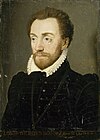
|
May 7, 1530 – March 13, 1569 |
Françoise d'Alençon
|
Henri I de Bourbon 1569–1588 |

|
December 29, 1552 – March 5, 1588 |
Eléanor de Roucy de Roye
|
Henry II de Bourbon 1588–1646 |
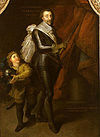
|
September 1, 1588 – December 26, 1646 |
Henri I de Bourbon
Charlotte Catherine de La Trémoille |
Louis II de Bourbon 1646–1686 |
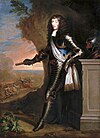
|
September 8, 1621 – November 11, 1686 |
Henry II de Bourbon
Charlotte Marguerite de Montmorency |
| Henri Jules de Bourbon 1686–1709 |
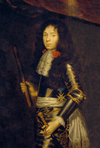
|
July 29, 1643 – April 1, 1709 |
Louis II de Bourbon
Claire-Clémence de Maillé-Brézé |
| Louis III de Bourbon 1709–1710 |
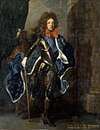
|
November 10, 1668 – March 4, 1710 |
Henri Jules de Bourbon Anne Henriette of Bavaria |
| Louis Henri de Bourbon 1710–1740 |

|
August 18, 1692 – January 27, 1740 |
Louise-Françoise de Bourbon
|
Louis Joseph de Bourbon 1740–1818 |
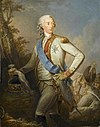
|
August 9, 1736 – May 13, 1818 |
Landgravine Caroline of Hesse-Rotenburg
|
Louis Henri Joseph de Bourbon 1818–1830 |
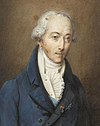
|
April 13, 1756 – August 30, 1830 |
Charles de Rohan
|
Second creation: 1845 –1866 – House of Orléans
| Name | Portrait | Lifespan | Parents |
|---|---|---|---|
| Louis d'Orléans | 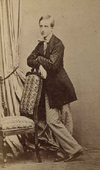
|
November 15, 1845 – May 24, 1866 |
Princess Maria Carolina Augusta of Bourbon-Two Sicilies
|
Styles of address
The eldest sons of the Princes of Condé used the title of
Although both the sons and daughters of these branches of the
Family residences

The
The family had several residences outside Paris – the
Notes
- ^ The Bourbons were, themselves, descended from the Capetian dynasty
References
- ^ Velde, François. "A list of French Princes and Principalities". Heraldica.org. Retrieved 2008-07-06.
- ^ Barko, Ivan (December 2003). "'Le petit Condé: the death in Sydney in 1866 of Australia's first royal visitor". Explorations - Journal of French-Australian Connections (35): 26–32. Archived from the original on 2013-04-24.
- ^ "Jeanne de Chatillon".
- ^ Spanheim, Ézéchiel (1973). Emile Bourgeois (ed.). Relation de la Cour de France. le Temps retrouvé (in French). Paris: Mercure de France. pp. 99–100, 107, 323, 329.
- ^ Nancy Mitford, The Sun King, 1966, p.87
